Giving Back: An Eco-tourism Experience at Tottori Sand Dunes
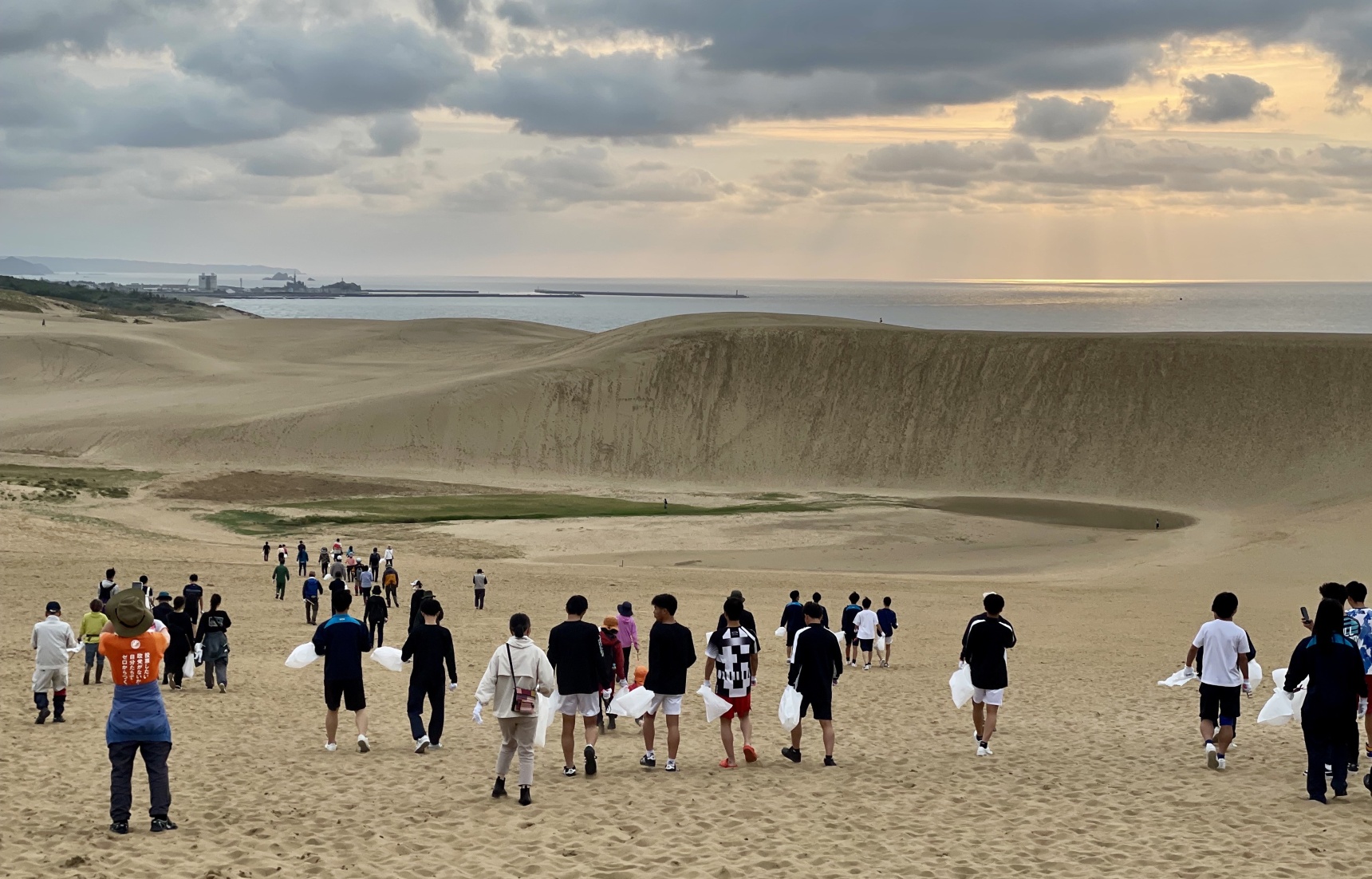
Visitors to the Tottori Sand Dunes walk towards the weeding site, ready for a new eco-tourism experience.
The Tottori Sand Dunes, one of the largest sand dunes in Japan, are among the most protected lands in the country. They are part of the San’in Kaigan Geopark, which is a UNESCO Global Geopark spanning Kyoto, Hyogo and Tottori Prefectures, and have been designated a National Natural Monument. Similar parks usually adopt a philosophy of minimal or no human intervention but, because the dunes are at risk due to the incursion of non-native plants, people are needed to help protect them.
By Kathryn WortleyTrowel and trash bag in hand, I join the crowd of approximately 100 people who have gathered in the car park of the Tottori Sand Dunes to join in a new eco-tourism experience. We are a diverse group ranging from retirees to businessmen and high school students, along with some families with young children. There are local people from Tottori and neighboring prefectures, as well as a few visitors from overseas.
We all have our reasons for taking part. Some want to help clean up the area and support community activities, while others want to set a good example for their children by volunteering. We are united in our ultimate goal, however: uprooting invasive plants on a section of this vast swathe of dunes that stretches for some 16 kilometers (9 miles) along the coast of the Sea of Japan.
Rolling Up Our Sleeves

Umanose (Horseback Dune) offers impressive views of the Sea of Japan.
As we climb the steep steps to reach the massive undulations of sand that make up the dunes, I can see the extent of the challenge facing us. Patches of green and brown vegetation cover large areas where we should see sand instead.
During our earlier visit to the adjacent visitor center, staff explained how these areas of the dunes have been covered by this vegetation over time. Colorful exhibits also described the diverse native flora that should be the only plants growing in this unique environment. As we look out on the dunes, we can spot a few examples, such as Asiatic sand sedge, whose V-shaped yellowish-green leaves peep out from the sand, and beach morning glory, characterized by its pink, trumpet-shaped flowers.
Still, after our brief, rudimentary lesson in the native vegetation, nothing is left to chance. We are guided by a Tottori Sand Dune Ranger to our weeding area of about 3,000 square meters Situated beside a small natural oasis, it offers impressive views of Umanose (“horseback”), the highest dune at 47 meters, and the Sea of Japan in the distance.
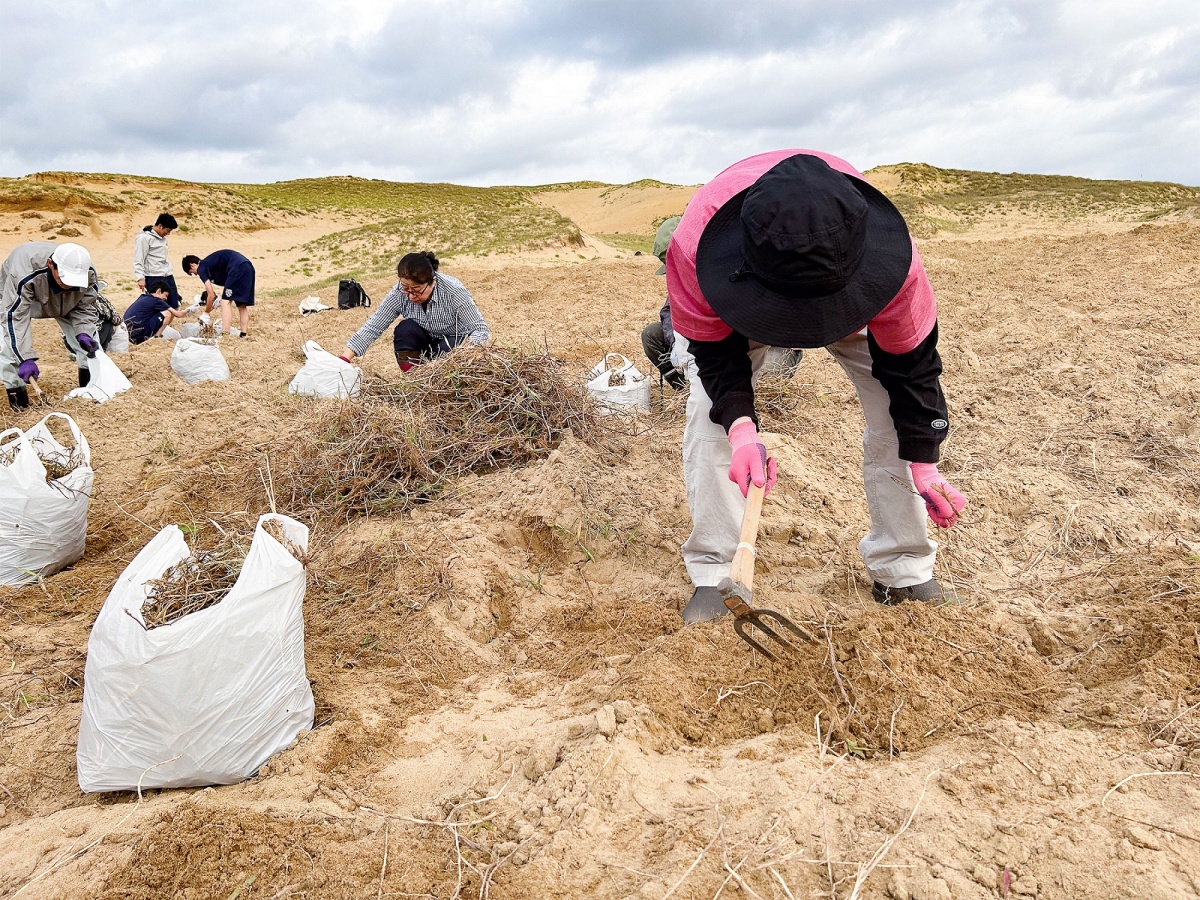
Volunteers work together to remove non-native vegetation and place it in bags.
Our ranger demonstrates the best method, stressing the importance of digging down to remove the roots in their entirety. He reminds us to take breaks occasionally to enjoy the natural beauty around us. The sun begins to set as we work, the glowing orange-red ball casting golden shadows across the dunes. It’s a reminder, one participant says, of the urgent need to preserve this precious environment for future generations.
With the 90-minute experience drawing to a close, the organizers collect the organic material we have all gathered: 120 bags. Later it will be transformed into compost and traditional washi paper—part of a sustainable initiative idea of a local high school student. Part of the proceeds from the sale of these products will be used to preserve the sand dunes for the future.
Past, Present, Future
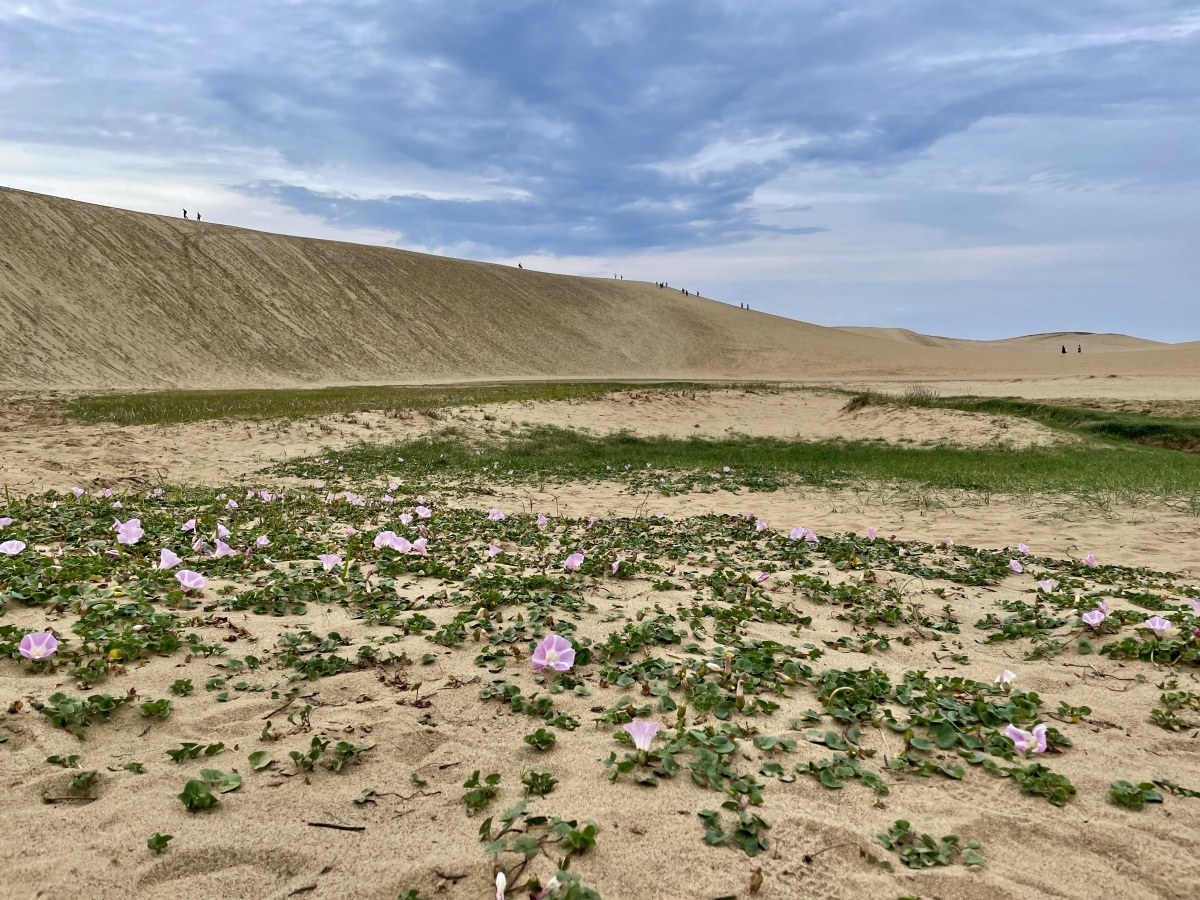
One type of native vegetation, beach morning glory, is characterized by its pink, trumpet-shaped flowers.
The ranger described the complexity of the problem of invasive vegetation encroaching on the dune environment. Seeds of non-native plants have long been introduced to the area, brought in on the wind, the soles of visitors’ feet or the fur of the native animals such as rabbits, deer, and wild boar. Over time, the invasive plants have spread, taking over the space of native plants, and disrupting the native wildlife.
These plants alter the way sand is moved by the wind, disrupting natural sand flow patterns and leading to the formation of mounds. Such changes to the dune ecosystem reduce the habitat for certain plant, animal and bird species, which can result in native biodiversity loss. They also affect the stability of the dunes, making them more susceptible to erosion and hindering visitors’ enjoyment of activities like sandboarding and paragliding.
If invasive plants are overlooked, the long-term survival of the entire ecosystem is at risk. With 1.3 million people visiting the Tottori Sand Dunes annually, the protection of the dunes is important not only for environmental reasons, but economic, social and cultural ones as well.
The situation reached its nadir in the 1970s, when about 40 percent of the dunes were overrun by invasive plants, according to the Tottori Sand Dunes Mirai Council Secretariat, the group responsible for their protection and management. In 1980, a committee was established to restore the dunes to their original state. With the help of residents and businesses, the committee organized weeding efforts each spring and fall, successfully reclaiming half of the selected area and returning it to sand.
Maximizing Eco-tourism
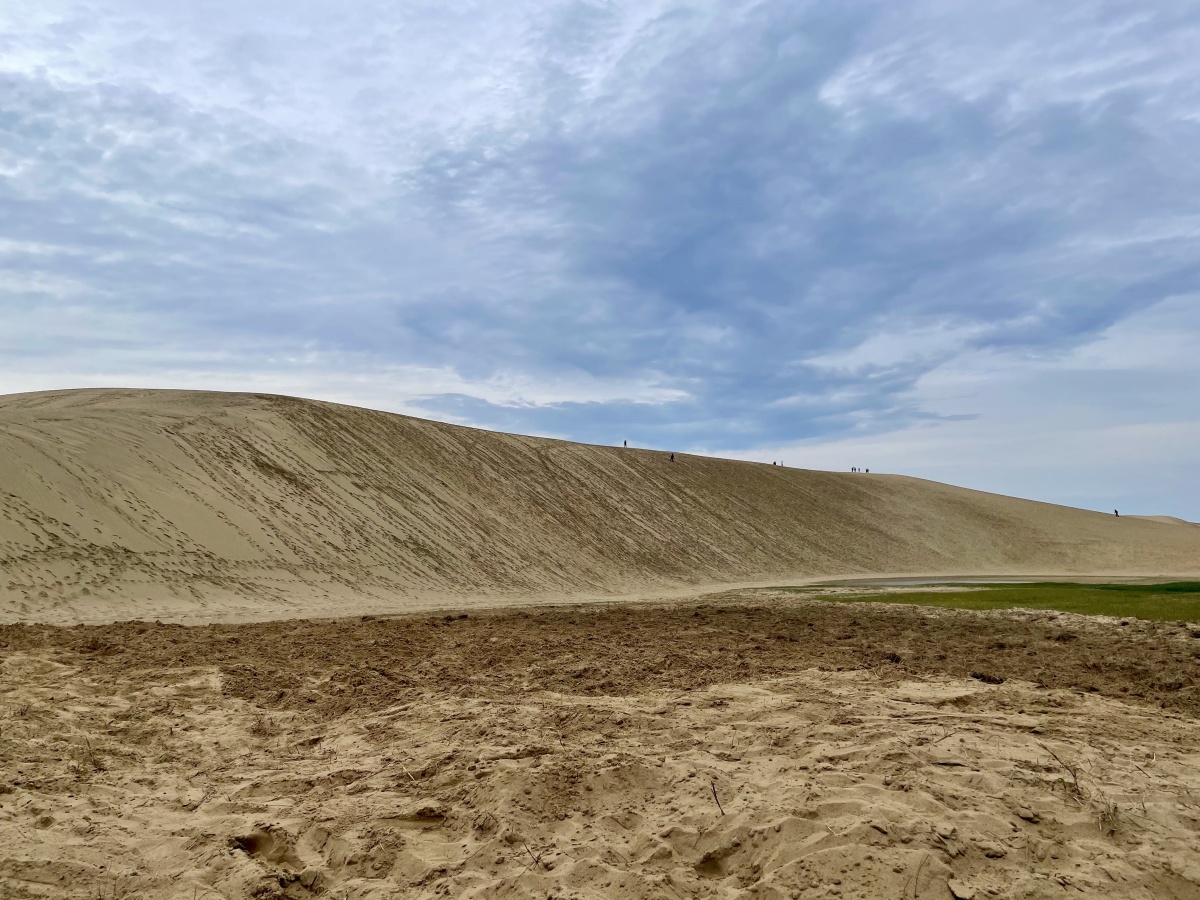
Approximately 20 percent of the Tottori Sand Dunes remains covered by invasive plants. This is the same spot as the previous photo, after the weeding.
Decades after the launch of restoration efforts and with 20 percent of the dunes still covered with non-native vegetation, Tottori is now enlisting the help of local residents and visitors from other parts of Japan and the rest of the world.
The initiative was inspired by Tottori’s recent partnership with the Sand Dune and Shingle Network, a UK-based nonprofit that promotes the sustainable use of coastal environments worldwide through research, consultancy, and events. As the network’s first Asian collaborator, Tottori marked World Sand Dune Day—an annual event organized to raise awareness of the ecological significance and cultural value of sand dunes—with the volunteer-powered weeding session I joined.
Celebrations continued into summer, with groups of local residents and visitors alike taking part in weeding sessions shortly after dawn and before sunset over several weeks. Indeed, the response to the call for volunteers has been so positive that officials plan to offer more eco-tourism experiences, so keep a look out for news about how to join.
As eco-tourism gains popularity among travelers to Japan, local tourism officials have high hopes following the initiative. “We believe our efforts to protect and preserve the dunes will raise awareness of their importance and inspire more visitors to come and experience them,” said Hirokazu Hirai, chief of the tourism and geopark promotion section at Tottori’s city hall.
Learning from Others
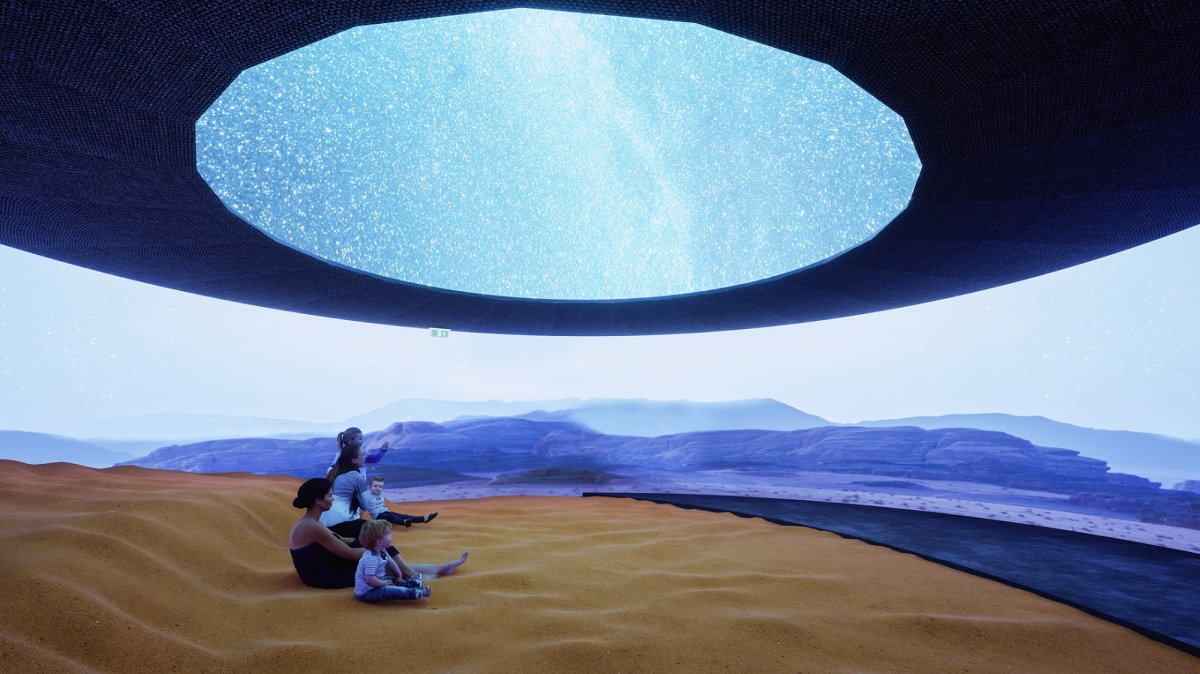
Jordan's Pavilion at Expo 2025 features sand transported from Wadi Rum, one of its protected areas.
Alongside the conservation initiatives, Tottori is also implementing “sand diplomacy” to raise international awareness of its dunes as a natural, cultural and economic resource. In recent months, the prefectural government signed “sand alliances” with the pavilions of Jordan and Saudi Arabia at Osaka’s Expo 2025, to leverage the destinations’ shared natural resource—sand—for cultural exchange and tourism promotion.
The tie-up between Tottori and Jordan was born from the natural synergy of their exhibits. To recreate the dune landscape at the Tottori Prefecture Zone, around 10 tons of sand were transported from Tottori to the Osaka site, and Jordan’s Pavilion features 22 tons of sand, transported from Wadi Rum, a natural and cultural World Heritage Site.
Marking the partnership, Tottori Governor Shinji Hirai said that Tottori and Jordan could “promote the wonders of sand dunes to people in Japan and overseas, and build a lasting exchange.” Jordan’s Acting Commissioner-General Shifa Zghoul Haddad added that the two regions have the potential to “create some wonderful collaborations” through sand.
Future of Tottori Tourism

The Sand Museum's exhibition, Japan, depicts the nation’s myths, history, and culture using sand as a medium.
As we regroup in the car park, the rangers thank us for our efforts and invite each of us to choose a souvenir as a keepsake. I select a miniature camel crafted from sand—a nod to both the camels that offer rides on the dunes and the incredible sand art exhibited at the nearby Tottori Sand Museum.
Building on the city’s deep connection to sand, the museum bills itself as the world’s only permanent indoor exhibition space dedicated entirely to sand art. Established in 2006, its mission is to showcase the beauty and expressive potential of sand as an artistic medium. Every work is created solely from sand and water, a unique challenge that has drawn leading artists from around the globe to Tottori.
The ongoing exhibition, Japan, which can be viewed until January 4, 2026, is part of the museum’s long running series “Travel Around the World in Sand.” Towering sculptures depict the nation’s myths, history, and culture in remarkable detail, likeness and scale, creating a truly immersive experience.
Over nearly two decades, the museum has introduced millions of visitors to the artistry and allure of sand. Now, with restoration efforts intensifying on the nearby sand dunes, the hope is that even more travelers will be inspired to visit. Some may even have a chance to try a weeding experience, a new way to enjoy Tottori while creating a positive legacy of their visit.

The sand art presents various important figures from Japanese history in remarkable detail.



